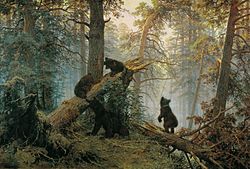Boreal (period)
|
Holocene Epoch |
|
|---|---|
 Morning in a Pine Forest, a painting by Ivan Shishkin and Konstantin Savitsky. |
|
| ↑ | |
| Holocene | |
In paleoclimatology of the Holocene, the Boreal was the first of the Blytt-Sernander sequence of north European climatic phases that were originally based on the study of Danish peat bogs, named for Axel Blytt and Rutger Sernander, who first established the sequence. In peat bog sediments, the Boreal is also recognized by its characteristic pollen zone. It was preceded by the Younger Dryas, the last cold snap of the , and followed by the Atlantic, a warmer and moister period than our most recent climate. The Boreal, transitional between the two periods, varied a great deal, at times comprising within it climates like today's.
Subsequent to the original Blytt-Sernander scheme, the first stage of the Boreal was divided off as a Pre-boreal transitional phase, followed by the Boreal proper. Some current schemes based on pollen zones also distinguish a pre-Boreal (pollen zone IV), an early Boreal (pollen zone V) and a late Boreal (pollen zone VIa, b, and c).
The generally accepted date for the end of the Younger Dryas and the start of the Pre-Boreal is 11,500 Before Present calibrated. The start of the period is relatively sharply defined by a rise of 7 °C in 50 years. The date is based fairly solidly on Greenland ice cores, which give 11,640 BP for the late Younger Dryas and 11,400 BP for the early Pre-Boreal.
But estimates of other dates vary by up to 1000 years, for a number of reasons. First, "Boreal" can identify a paleoclimate, a pollen zone or a temporally-fixed chronozone, and those three bases of definition allow quite different dates. Second, different dating methods obtain different dates. The underlying problem is that climate and pollen vary somewhat from region to region. The scientists of each region use the methods available in their region, whether lake varves, the annual layers of sediment from ancient or modern lake bottoms, ice cores or counts of tree rings (dendrochronology).
...
Wikipedia
